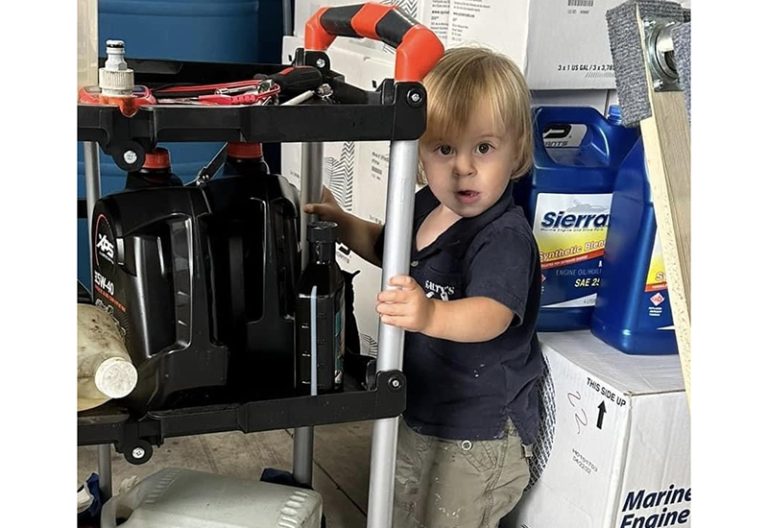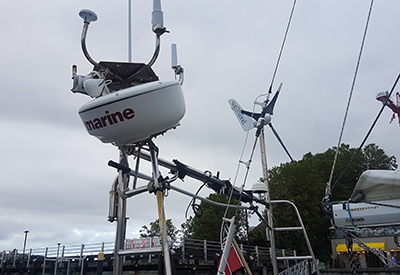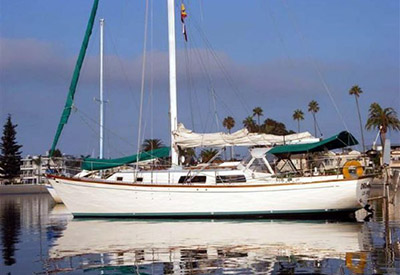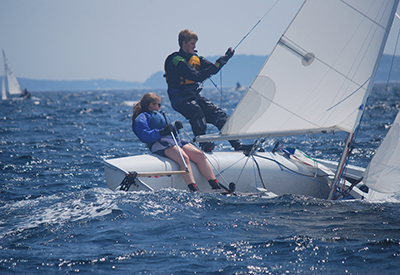The Voyage of Free Spirit V – Starting From Scratch
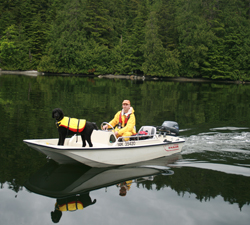
Bitten by boating bug, the author and her husband choose a rugged 42’ passagemaker and start their climb up a steep learning curve…
In the beginning…
…we lived on the prairies. We did not know a tide from a current but we harboured a dream of moving west, where we could see the ocean every day. We had spent a lot of time in Vancouver and, as the possibility of moving there drew near, we felt the urge to be out on the water – not just to look at it.
In early 2009, a prairie friend bought a sailboat on the West Coast. Over the next several months, my husband Rob spent time on his friend’s boat and completed a three-day sailing course, as well as courses in coastal navigation, docking, anchoring and diesel engine maintenance. When he gave me a life jacket for my birthday that spring, I figured it was time for me to get on board. So, in the summer 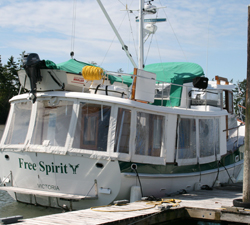 of 2009, I took two one-day sailing lessons, and in November 2009, we headed out with an instructor for three days. Despite our experience with prairie winters, 40-knot winds and lashing rain gave us pause. We loved the wintry sky and waters but would have preferred a drier, more comfortable vantage point than the cockpit of a sailboat.
of 2009, I took two one-day sailing lessons, and in November 2009, we headed out with an instructor for three days. Despite our experience with prairie winters, 40-knot winds and lashing rain gave us pause. We loved the wintry sky and waters but would have preferred a drier, more comfortable vantage point than the cockpit of a sailboat.
With very limited knowledge of boats, we thought our only other option was a fast, planing powerboat. I can see the appeal of such sleek vessels, but that did not suit us. So we were resigned to fair-weather sailing on other people’s boats, as “marginally competent crew.”
Then, one day in the spring of 2010 and immediately before he departed on a two-month cruise, a new friend – let’s call him “Bill” – casually mentioned to Rob that we should consider a “full-displacement-hull trawler.” I liked the sound of those four words. They sounded solid. And warm. And dry. I did a quick  search… Not surprisingly, there was a lot of information online, and soon I was randomly spouting nautical jargon and explaining to Rob how these boats differed from “semi-displacement” and “planing” hulls. Rob was interested but cautious. We had just completed our move to Vancouver and hadn’t done any boating since our brief foray the year before; the small amount I had learned seemed long gone.
search… Not surprisingly, there was a lot of information online, and soon I was randomly spouting nautical jargon and explaining to Rob how these boats differed from “semi-displacement” and “planing” hulls. Rob was interested but cautious. We had just completed our move to Vancouver and hadn’t done any boating since our brief foray the year before; the small amount I had learned seemed long gone.
Still, in short order, I located a full-displacement trawler for sale in nearby Sidney, and said to Rob, “What good luck? Can you believe it?” He responded: “Let’s not make any decisions until Bill gets back…” “Of course. Of course,” I said. “Let’s just go take a look.”
The Boat
A few weeks later, after installing one of the kids in Victoria for the school year, we popped into the nearby brokerage to see Free Spirit V, a 1991 42’ Kadey Krogen pilothouse trawler. We liked what we saw. Very much. The attributes that 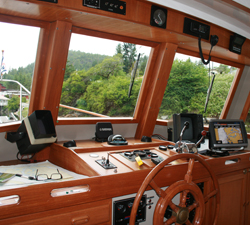 appealed to us included a slow but steady temperament, fuel efficiency, immaculate condition (even the engine room), a wonderful pilothouse, a spacious saloon, two heads (better than one), and an old-world aesthetic with lots of teak inside. She was a stout, cozy boat. But we didn’t know much about her. We did know that she cost more than we wanted to spend. So we spent a long time quietly sitting inside her, standing on the dock and climbing on the “roof.” The broker gave us a basic lesson on the different parts of the boat, the fact that it had a single engine and a modest bow thruster and what that meant. We left for the ferry, exhausted.
appealed to us included a slow but steady temperament, fuel efficiency, immaculate condition (even the engine room), a wonderful pilothouse, a spacious saloon, two heads (better than one), and an old-world aesthetic with lots of teak inside. She was a stout, cozy boat. But we didn’t know much about her. We did know that she cost more than we wanted to spend. So we spent a long time quietly sitting inside her, standing on the dock and climbing on the “roof.” The broker gave us a basic lesson on the different parts of the boat, the fact that it had a single engine and a modest bow thruster and what that meant. We left for the ferry, exhausted.
When Bill returned from his summer travels, Rob called him to ask if he had ever heard of a Kadey Krogen 42′ pilothouse trawler. “Yes, I own one” he replied. Bill and his wife Eileen had the same boat! They graciously took us out on Ceilidh I for an evening cruise. As we steamed under the Lions Gate Bridge, Rob and I sat rapt on the watch berth. Over dinner that evening, Bill said, “We think you’re really going to do this!”
 He was right.
He was right.
Like most people, we’ve bought many things in our adult lives: a house, a car, a standard poodle. And we’re both lawyers. So we thought this purchase would be intuitive and easy for us. In fact, it was not. We faced a steep learning curve. Bill had not seen the boat but with his help we felt confident that we were taking the right steps and were able to enjoy the process. First-time boat buyers need an experienced and trusted advisor and we were very lucky on that front.
When we decided to make an offer on the boat, friends cautioned us: “The best two days of a boat owner’s life are the day you buy the boat and the day you sell the boat.” But we really wanted this boat! We put on our best poker faces and commenced negotiations. In the end, we were not unhappy with the outcome; it seemed fair to both parties. We stipulated that the purchase would include all contents. This made a big difference to us. We had never before owned a 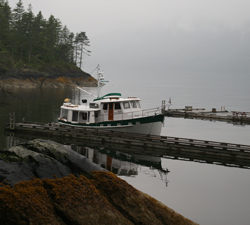 proper tool kit and the turnkey approach provided us with every tool and spare part the previous owner, a seasoned mariner, had deemed necessary. Also included were extensive charts, high-end fishing rods and tackle, and a well-outfitted galley. Months later, as we explored every nook and cranny of our new boat, we continued to find amazing things, like two Ocean Class PFD inflatable suits stuffed into cupboards under the saloon settee.
proper tool kit and the turnkey approach provided us with every tool and spare part the previous owner, a seasoned mariner, had deemed necessary. Also included were extensive charts, high-end fishing rods and tackle, and a well-outfitted galley. Months later, as we explored every nook and cranny of our new boat, we continued to find amazing things, like two Ocean Class PFD inflatable suits stuffed into cupboards under the saloon settee.
The Purchase
We made our offer subject to a satisfactory marine survey, a mechanical inspection and a sea trial, as well as assignment of the moorage. The inspections were done by experts of our choosing and at our expense. We were present for every step and even turned the sea trial into a lesson. We carried notepads, climbed up and down and into the engine room with the pros, and started our maintenance log by writing down every word that was spoken. And we followed up on every comment.
All of these procedures went smoothly and we figured the boat was shipshape and ready to go. Wrong. What we didn’t realize was that these inspections and tests touched only on the most fundamental systems. We did not know, for example, that the wiring, patched over the years with automotive connections, would need attention. Or that the heater would not work. Or that the fresh-water pump would conk out on Boxing Day while I was in the shower. None of these were scrutinized before the purchase. In truth, the latent deficiencies would not have had much impact on the sale. But we had seriously underestimated what it would take to get this boat ready for a lengthy summer cruise.
By November 2010, I had successfully completed a coastal navigation course and a couple of weeks later, in early December, the sale closed. The previous owner traveled from out of province to retrieve personal items and bid farewell to the boat he loved. And then she was ours. With breathtaking naïveté, we told Bill that all we needed to buy was an inverter, a chartplotter and new fuel filters, and we’d be ready to go. He laughed. Silly novices. We learned that in the boating vernacular, $1,000 equals one boat unit, and we were soon spending many more boat units than we had expected.
The Spending Spree
We knew we needed to update the boat’s navigational technology. The original Loran navigation system was still in place. What is Loran? The boat had a basic GPS but no chartplotter. The radar and depth sounder worked but looked like Soviet-era artifacts. When we purchased a new touch¬-screen plotter with radar and depth sounder, we were advised to remove the old radar and depth-sounding systems on aesthetic grounds – because they “dated the boat.” We resisted, convinced that back-up systems could be a good thing. Our decision has been endorsed on several occasions.
We also resisted the suggestion to install a stronger bow thruster. Single-engine boats can be notoriously difficult to dock, particularly for novices, but Bill, a purist, encouraged us to focus on the principles and technique and resist relying heavily on the bow thruster. Easy for him to say…
Bill did suggest that we install dual Racor primary fuel filters so we could switch filters while under way with just a flip of a lever, without having to actually replace the clogged filter and bleed the fuel lines while drifting on a rolling sea.
We learned about DC electrical systems, and Rob read The 12-Volt Bible for Boats by Miner Brotherton and Ed Sherman. Fun times. Deciding that we needed AC power while at anchor and preferring not to run the generator in a quiet anchorage just to make a cup of coffee, we elected to install an inverter. With the inverter came a massive new bank of house batteries, so heavy that it took two men to lift them onto the boat.
In the midst of all this acquisition, one of us said, “Let’s go somewhere!” “But we can’t,” said the other. Our nine-year-old standard poodle, Blue, looked at us beseechingly. He was avoiding all stairs and walking in a stilted, stiff-legged fashion, uneasy with the boat’s slightest movement. We hired the same highly regarded instructor who had accompanied us on our sea trial and asked him to take us, including the dog, out for three days. In mid-December, within a week or so of closing the sale and with some but not all of our new equipment installed, we traveled to Poet’s Cove on Pender Island, then on to Ganges Harbour, Salt Spring Island. Typical winter weather meant we saw almost no other pleasure boats and the visitor docks were empty. That was the good part.
Rob and I slept below deck and our instructor, Bruce, slept in the saloon. At Poet’s Cove, the wind rocked our boat so fiercely that our 70-pound poodle climbed into bed with Bruce. Understandably, Bruce demurred, and we awoke to the sound of Bruce struggling to get Blue off his berth. In the middle of the night, the three of us, in our pajamas, wrestled the dog down the few steps leading to the lower berths and installed him in a bottom bunk. He curled up and went to sleep.
Maiden Solo Voyage
December was a tough month. After a series of lessons, Bruce gave us the green light to make a solo trip to Salt Spring over the holidays. We decided to spend Christmas on the boat and head out on Boxing Day. We cleaned and shopped and invited my brother to join us. On Boxing Day, we were keen to go somewhere but the wind was howling. I got into the shower and soaped up my head. That’s when the fresh-water pump failed. Hmmm. My brother caught the next ferry back to Vancouver. Understandable. We were planning to follow him. And then we decided not to. So what if we didn’t have fresh water. We could manage. We decided to leave the following morning.
To say we were nervous does not begin to describe our state of mind. We pulled away from the dock and moved ahead. But the wind gusted and soon we were too close to the boathouses that lined our path out of the marina. At the bow, I actually tried to push us off an anchor on the bow of a large boat docked perpendicular to us – and our boat weighs 50,000 pounds. I yelled to Rob in the pilothouse. We made a narrow escape and steamed ahead.
Outside the marina, in John Passage, the water was turbulent and I had a moment of panic. “Did we need to check currents?” I said in a high, pinched voice. It helped to hear Rob say “No,” but it was less comforting when he added “And anyway, it’s too late now.” My anxiety soared and for the rest of John Passage, Rob both drove the boat and admonished me to “Get a hold of yourself!” We left John Passage and encountered ferry traffic, which also sent me reeling. Rob was probably anxious too but his annoyance with me proved a handy distraction.
We reached Ganges without incident and undertook our first solo docking experience. There were no other boats at the public dock and it was a simple approach. I was ready to step off and secure a line when a few fellows from nearby live-aboards took the line from me. They complimented our boat. I told them it was our first solo voyage. They said we seemed expert. We were jubilant and thoroughly exhausted.
And then I went to wash my hands and the water came back on. It was a sign. I decided to take a shower. While I was in the shower, the wind picked up so severely that the boat rocked and I was completely nauseated by the time I stepped out. Gravol, wine and a nice dinner out rounded out the evening.
Our return trip the next day was uneventful, although I winced at the sight of every ferry. When we reached our marina, we were again nervous, remembering our inauspicious departure. There was no one around and the wind was against us. I would have to step off and quickly secure the boat to the dock. No problem. Rob tried to get close to the dock. The wind blew us off. He tried again. I felt for him. That’s why I jumped. I know that is wrong. I knew it then, too. But I just had to get on the dock and it looked so close. I did not fall in the water. However, the dock was slick with ice and I did a pretty good baseball slide, which I punctuated by sharply bonking my head on the dock. I also let go of the line and screamed. Rob looked out of the pilothouse window. I was lying on the dock. “Oh my God!” he said. “I’m hurt,” I whimpered.
He was now single-handing the boat and the wind was pushing him further and further away. Somehow, he managed to get close enough to throw me a line. I caught it but still I was not helpful. I tied it to the wrong place on the dock and in the process invented a new knot I could not undo. I also found a spare fender and insisted that it must immediately be affixed to an unlikely spot on our boat.
Rob realized that this was no time to quibble with me – I must have a head injury. He tied on the rogue fender exactly as I requested and then stepped off. With much effort he undid my knot. Together we pulled the boat into place and secured the lines. And then we laughed. And laughed and laughed. We had made it and no one lost an eye.
In succeeding months, we would log about 100 hours, preparing ourselves and outfitting the boat to accompany Bill and Eileen north for the summer.
Next Issue: On to Ocean Falls!
Story & Photos by Elizabeth Regan
Photo Captions:
1. The author’s husband Rob Abells and boat dog Blue.
2. Free Spirit V, a 1991 Kadey Krogen 42, is a stout, cozy boat that impressed us with her slow, steady temperament, fuel efficiency, immaculate condition and spacious accommodations.
3 & 4. We love our boat for her wonderful pilothouse, her spacious saloon, and an old-world aesthetic with plenty of teak. One of our first tasks was to update her aging electronics.
5. Skeptical at first, our poodle Blue learned to relax and love boating.
6. Early on our first trip north, we stopped at Burrard Yacht Club’s Ekins Point outstation on Gambier Island.

